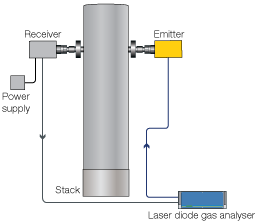The nature of steel manufacturing processes places severe limitations on the monitoring methods that can be used. Aggressive environments combined with high levels of particulates and gases make the choice very limited.
OPSIS monitoring systems are designed for such environments, where they are already meeting the demands for reliability and performance on many sites around the world. Using UV/FTIR
DOAS (Differential Optical Absorption Spectroscopy) or
TDL (Tuneable Diode Laser) technique, an OPSIS system provides an open-path, non-contact monitoring system unaffected by the gases, temperatures and particulates typical of steel manufacturing processes.
The technique used is the most suitable for the current application. Being able to monitor a range of user specified compounds continuously in real time with a single system, the OPSIS instruments offer high levels of accuracy, reliability and data capture. They also offer the speed of response needed for process control.
Besides monitoring common gases such as nitric oxide (NO), nitrogen dioxide (NO
2), sulphur dioxide (SO
2), carbon monoxide (CO), carbon dioxide (CO
2), ammonia (NH
3), hydrogen chloride (HCl), oxygen (O
2) and water vapour (H
2O), systems are available to meet the specific needs of particular users:
Mini mill –Electric Arc Furnace
monitoring O
2, temperature, NO
x, NH
3
Coke plant
monitoring VOC’s, benzene, SO
2, NO
X, O
2, CH
4, CO, CO
2, NH
3, H
2S
Steel making – Converter
monitoring SO
2, NO
X, O
2, CO, CO
2, temperature
Sinter plant
monitoring SO
2, NO
X, NH
3
Steel production – Hot strip mill – Slab reheating
monitoring SO
2, NO
X, O
2, NH
3, temperature
Steel rolling – Pickling line
monitoring HCl
Features
- Multiple monitoring points using a single analyser
- No sampling required, non-contact measurement system
- Best performance according to QAL 1 certification
- Longest calibration interval according to QAL 1 certification
- Fast response time for process control applications
- Applications with high dust level, highly corrosive environments, and high temperature
- Can be installed in explosive areas
- AQM and fence-line monitoring capabilities
- Low energy consumption
- Gas calibration only once per year
- Internationally approved
- Thousands of systems installed worldwide
- Serviced by highly skilled service network
System Overview

